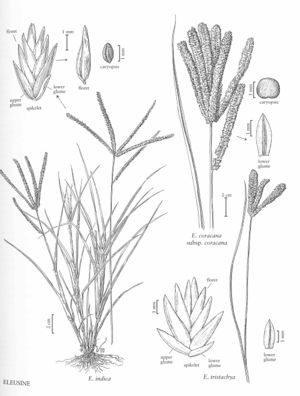Difference between revisions of "Eleusine coracana subsp. coracana"
FNA>Volume Importer |
FNA>Volume Importer |
||
| Line 1: | Line 1: | ||
{{Treatment/ID | {{Treatment/ID | ||
|accepted_name=Eleusine coracana subsp. coracana | |accepted_name=Eleusine coracana subsp. coracana | ||
| − | |accepted_authority= | + | |accepted_authority= |
|publications= | |publications= | ||
|common_names=Finger millet;Ragi | |common_names=Finger millet;Ragi | ||
| Line 16: | Line 16: | ||
-->{{Treatment/Body | -->{{Treatment/Body | ||
| − | |discussion=<p>Eleusine coracana subsp. coracana is the domesticated variant of E. coracana. Biochemical data suggest that it evolved from a few populations of the very variable subsp. africana. It is cultivated at various agricultural experiment stations and occasionally escapes.</p><!-- | + | |discussion=<p><i>Eleusine coracana </i>subsp.<i> coracana</i> is the domesticated variant of <i>E. coracana</i>. Biochemical data suggest that it evolved from a few populations of the very variable <i></i>subsp.<i> africana</i>. It is cultivated at various agricultural experiment stations and occasionally escapes.</p><!-- |
| − | --><p>Eleusine coracana subsp. coracana has a long historical record dating back at least 5000 years in Africa, and 3000 years in India. Five races, based on inflorescence morphology, are recognized in East Africa where it is widely cultivated for food and drink.</p> | + | --><p><i>Eleusine coracana </i>subsp.<i> coracana</i> has a long historical record dating back at least 5000 years in Africa, and 3000 years in India. Five races, based on inflorescence morphology, are recognized in East Africa where it is widely cultivated for food and drink.</p> |
|tables= | |tables= | ||
|references= | |references= | ||
| Line 26: | Line 26: | ||
-->{{#Taxon: | -->{{#Taxon: | ||
name=Eleusine coracana subsp. coracana | name=Eleusine coracana subsp. coracana | ||
| − | + | |authority= | |
| − | |authority= | ||
|rank=subspecies | |rank=subspecies | ||
|parent rank=species | |parent rank=species | ||
| Line 33: | Line 32: | ||
|basionyms= | |basionyms= | ||
|family=Poaceae | |family=Poaceae | ||
| − | |illustrator=Linda A. Vorobik | + | |illustrator=Linda A. Vorobik;Karen Klitz |
| + | |illustration copyright=Utah State University | ||
|reference=None | |reference=None | ||
|publication title= | |publication title= | ||
|publication year= | |publication year= | ||
|special status= | |special status= | ||
| − | |source xml=https:// | + | |source xml=https://jpend@bitbucket.org/aafc-mbb/fna-data-curation.git/src/f50eec43f223ca0e34566be0b046453a0960e173/coarse_grained_fna_xml/V25/V25_178.xml |
|subfamily=Poaceae subfam. Chloridoideae | |subfamily=Poaceae subfam. Chloridoideae | ||
|tribe=Poaceae tribe Cynodonteae | |tribe=Poaceae tribe Cynodonteae | ||
Revision as of 20:36, 16 December 2019
Culms to 17 cm. Blades 30-60 cm long, 6-12 mm wide. Branches 4-14 cm long, 7-15 mm wide, spikelets closely imbricate. Spikelets 5-9 mm long, brown, with 6-9 florets, florets not disarticulating at maturity. Seeds almost globose, brownish, surfaces granular to smooth.
Discussion
Eleusine coracana subsp. coracana is the domesticated variant of E. coracana. Biochemical data suggest that it evolved from a few populations of the very variable subsp. africana. It is cultivated at various agricultural experiment stations and occasionally escapes.
Eleusine coracana subsp. coracana has a long historical record dating back at least 5000 years in Africa, and 3000 years in India. Five races, based on inflorescence morphology, are recognized in East Africa where it is widely cultivated for food and drink.
Selected References
None.
